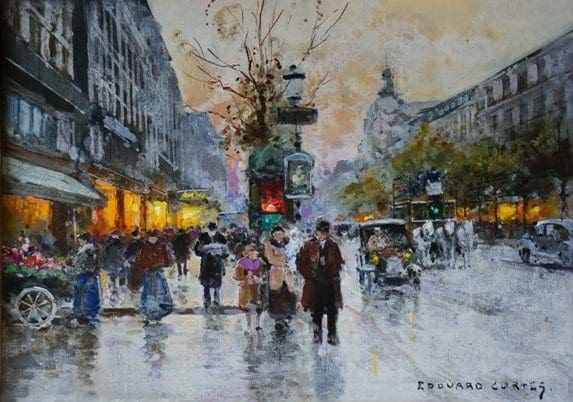
Edouard Cortès
French Artist
1882-1969
Interested in selling a piece by Edouard Cortès?
We have received top dollar for Edouard Cortès works. Auction is the best way to quickly and transparently get maximum dollar for your artwork.
About Edouard Cortès
Edouard Cortès was a famous French post-Impressionist artist. His paintings capture La Belle Epoque, or “Beautiful Age” of Paris between the end of the Franco-Prussian war in 1871 and the start of World War I in 1914. Through his use of bold brush strokes and intriguing colors, Cortès expressed the charm, energy, and romance of old Paris.
Biography
Edouard Leon Cortès was born in 1882, in Lagny, France. He came from a family of artists, as both his father, Antonio Cortès and his grandfather, Andrés Cortès, were well-known painters. Edouard Cortès’ stepbrother and sister were also talented painters.
By the age of sixteen, Edouard Cortès had already exhibited one of his works at the Société des Artistes Francais. Enrolling at the École des Beaux-Arts in Paris at age seventeen, Cortès fell in love with the city of Paris and its vibrant street life. In addition to his expressive street views of the city, he painted familial interiors, landscapes, and seascapes. Cortès participated in annual exhibitions and traveled the countryside, often staying with his sister and her family in Normandy.
By 1910, Cortès was actively participating in almost every major exhibition in France, displaying his paintings and pastels at the Paris Salon, the Toulouse International Industrial Salon, the Union Artistique des Ardennes, the Société des Amis des Arts de l’Avallonnais, the Société Artistique de Charenton, and the Société des Artists Girondins at the Autumn Salon in Bordeaux. He also joined the Association of French Landscape Painters under the leadership of Henri Harpignies.
Shortly after his marriage to Fernande Joyeuse in 1914, Cortès enlisted in the French army. As he moved during the Great War from one regiment to another, Cortès recorded the military life in postcard drawings that he sent home to his wife. After the war, he returned to Paris before settling in Lagny, where he painted springtime landscapes, flowering shrubs, and wisteria vines. At this time, Cortès discovered that his work was appreciated beyond France, and he began to send his work to selected art dealers in the Canadian and American markets.
Cortès continued his regular exhibition in Paris and around France, persisting through the 1930s and the tumultuous period of the Second World War. Through this time his paintings grew in popularity among American art collectors, allowing Cortès to support his family, including his sister and two of her daughters. Cortès continued to paint into his old age, submitting paintings to annual exhibitions before his death in 1969.
Cortès’ Artwork and Market
Edouard Cortès is known mostly for his paintings of Parisian streets. He was inclined to paint these scenes at the same location, at different times of day, during different seasons in the year, and even at intervals of several years apart. His work is often considered synonymous with the La Belle Epoque, as a type of time capsule of that era.
Cortès’ paintings have always enjoyed a steady popularity, both in his lifetime and since his death. The market has maintained a strong demand for his paintings, with many fetching five-figure prices over the last several years. Of all his work, the Parisian street scenes are still the most popular and in demand.
Where to Appraise and Sell Edouard Cortès’ Artwork
If you have any works by Edouard Cortès, especially his landscapes or street scenes, get in touch with our experts at Revere Auctions. If you would like to sell your Cortès paintings, you can auction them at our location in St. Paul, Minnesota. We also offer our services online.
You can contact us anytime for a free auction estimate if you want to sell Cortès’ work. We have a very simple process. After you send us the photos of the work, our experts will take a look, analyze, and provide you an estimate of the amount the artwork is likely to reach at auction.
If you need an appraisal for Cortès’ work, we provide a certified appraisal report that can be used for estate taxes, donations, and insurance coverage. Our appraisals are compliant with Uniform Standards of Professional Appraisal Practice and are accepted by insurance companies, charity agencies, and the IRS.